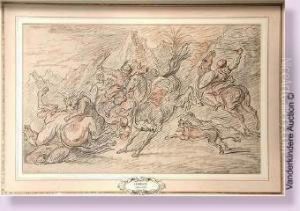Louis Parrocel Paintings
Louis Parrocel was a French Baroque painter, born in Brignoles, a small town in the Provence region, in 1634. He came from a family of painters, which included his father Barthélemy Parrocel and his brothers Joseph and Pierre Parrocel, who were also well-regarded artists in their own right. This familial background provided a fertile environment for his early training and development as an artist.
Louis Parrocel moved to Paris to further his career and was influenced by the Italianate style of painting, which was popular in France during the 17th century. This style was characterized by dramatic use of light and shadow, a vivid color palette, and dynamic compositions, elements that Parrocel incorporated into his own work. He is best known for his battle scenes and depictions of military campaigns, which were in high demand at the time due to the ongoing wars and the tastes of the French aristocracy.
Parrocel's talent in portraying horses and the tumult of battlefields garnered the attention of important patrons, including members of the French royalty. He was commissioned to create large-scale works that glorified the military conquests of Louis XIV. These works were not only meant to be visually impressive but also served as propaganda to promote the power and successes of the king's reign. Parrocel's battle scenes are remarkable for their energetic brushwork and the sense of movement and chaos that they convey, making them some of the most memorable images of French Baroque art.
Despite his success as a painter of battle scenes, Parrocel's oeuvre was not limited to this genre. He also painted religious scenes, landscapes, and portraits, although these works are less well-known today. His style evolved over his career, but he consistently demonstrated a strong ability to capture the human figure in action and to create dramatic, engaging compositions.
Louis Parrocel's legacy is somewhat overshadowed by the prominence of his more famous contemporaries and successors. Nevertheless, he made a significant contribution to French Baroque painting, and his works can be found in several museums and collections in France and around the world. Parrocel passed away in 1694 in Paris, leaving behind a body of work that continues to be studied and appreciated for its artistic merit and historical value.

